I know many of you will laugh and scoff but the evidence is overwhelming that dinosaurs and man coexisted. We, that is western society, have been brainwashed or indoctrinated with the evolutionists' story that dinosaurs died out 70+ million years ago and sadly many people believe it without even questioning it. I even believed in the story until I became a truth seeker and began to grow very, very skeptical of the evolutionists' story of dinosaurs dying out millions and millions of years ago. It's apparent to me that we've been lied to.
So let's take a look at the evidence with an open mind, shall we?
Dino tissue discovered. Wait, what? http://www.youtube.com/watch?v=6hhsx80P1PQ
Consider the conclusions that Schweitzer and her team made concerning these findings:
"The production of antibodies specific for hemoglobin in tworats injected with the trabecular extract is striking evidence for the
presence of hemoglobin-derived peptides in the bone extract. . . Thatthe antisera did not react with snake hemoglobin shows that the
reactivity is specific and not artifact. . . When considered as a whole, the results support the hypothesis that heme prosthetic groups and
hemoglobin fragments were preserved in the tissues of the Late Cretaceous dinosaur skeleton."
What looked, appeared, seemed etc. to be like red blood cells were in fact red blood cells. Otherwise it wouldn't have contained hemoglobin or myoglobin proteins. And they showed it did contain hemoglobin or myoglobin proteins through the immunological test. This immune response was not only against heme, but hemoglobin, and not just hemoglobin in general, but against a certain type of hemoglobin.
"This shifting perspective clicked with Schweitzer's intuitions that dinosaur remains were more than chunks of stone. Once, when she was working with a T. rex skeleton harvested from Hell Creek, she noticed that the fossil exuded a distinctly organic odor. "It smelled just like one of the cadavers we had in the lab who had been treated with chemotherapy before he died," she says."
Do you really believe dino tissue can retain its scent for 70+ million years?
http://discovermagazine.com/2006/apr/dinosaur-dna
What do some scientists have to say:
Dr. David Menton, Ph.D. in cell biology from Brown University wrote that "it certainly taxes one's imagination to believe that soft tissue and cells could remain so relatively fresh in appearance for the tens of millions of years of supposed evolutionary history. this would be a tall order, even if they were kept frozen in liquid nitrogen in a lab."
Jeffrey Bada, an organic geochemist at the Scripps Institution of Oceanography in San Diego: "Even if the T. rex had died in a colder, drier climate than Hell Creek, environmental radiation would have degraded its body....Bones absorb uranium and thorium like crazy. You've got an internal dose that will wipe out biomolecules."
Mary Schweitzer said herself "um well, it is it's very amazing it's utterly shocking actually, because it flies in the face of everything we understand about how cells, and tissues degrade..."
“It was exactly like looking at a slice of modern bone. But, of course, I couldn’t believe it. I said to the lab technician: “The bones, after all, are 65 million years old. How could blood cells survive that long?’”
And that's not the only preserved dino discovered. Video of a so called Dino Mummy http://www.youtube.com/watch?v=sSYFmyn3n3c
You may inquire "well, how come there are no art depictions of dinosaurs in cultures throughout the world if they coexisted with man?". Actually there are!
And now we have the Ica Stones which contain hundreds of art depictions of dinosaurs and humans together as if it was a normal part of their culture. The Ica Stones http://www.youtube.com/watch?v=NPO6h8M6DI4&feature=related
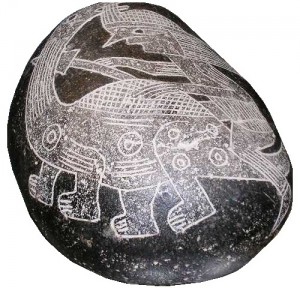
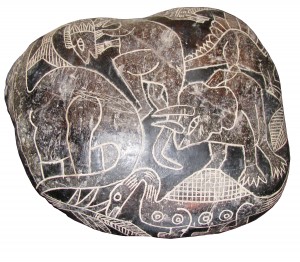
".. fascinating Chinese artifact is the Late Eastern Zhou Sauropod (Fang Jian) ornamental box to the right. Displaying a tridactyl foot, a long neck and a head that resembles a Brachiosaur, this depiction is compelling. (Fong, Wen ed., The Great Bronze Age of China, Metropolitan Museum of Art, 1980,p. 285.)"
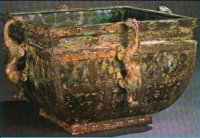
"The seated dragon sculpture in cast bronze to the left comes from the Tang Dynasty (618-906 AD) and is currently housed at the Los Angeles County Museum of Art."
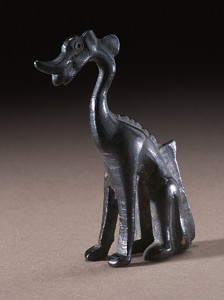
"... is another beautiful mosaic that was one of the wonders of the second century world (click to enlarge). Called the Nile Mosaic of Palestrina, it depicts Nile scenes from Egypt all the way up into Ethiopia. Scholars now believe this is the work of Demetrius the Topographer, an artist from Alexandria who came to work in Rome. The top portion of this remarkable piece of art is generally believed to depict African animals being hunted by black-skinned warriors. These Ethiopians are pursuing what appears to be some type of dinosaur. The Greek Letters above the reptilian animal in question are: KROKODILOPARDALIS which is literally translated Crocodile-Leopard (apparently identifying an agile reptilian creature). The picture shown here is only a small portion of the massive mosaic. It also contains clear depictions of known animals, including Egyptian crocodiles and hippos. (Finley, The Light of the Past, 1965, p. 93.)"
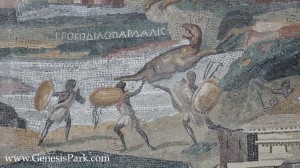
"In May of 2012 researcher Vance Nelson brought to our attention a panel of pictographs on a rock ledge found in the Amazon rainforest. This artwork is said by secular archaeologists to be thousands of years old. Amazingly, one of the pictographs shows nine warriors hunting what appears to be a dinosaur. In the 1940’s the American explorer Percy Fawcett brought back reports of a large dinosaur-like creature from this same region of the Amazon."
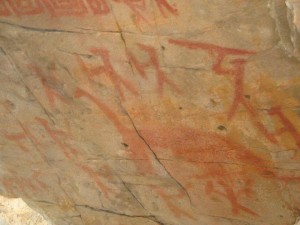
The February 26, 2000 issue of Science News contained an article that commented on a Hesione vase artifact housed at the Boston Museum of Fine Arts (Hesman, 2000). On this ancient Greek vase are a series of somewhat unusual paintings, including one that portrays a monster with the head of a dinosaur. This pottery was created around 550 B.C. and depicts the Greek hero Heracles rescuing Hesione from this “monster of Troy.” Forced to concede that it is an amazingly realistic dinosaurian depiction, Science News concluded that the paintings on this unusual vase simply prove that ancient people dug up and assembled fossils. But there is no evidence for sophisticated Ancient Paleontologists.
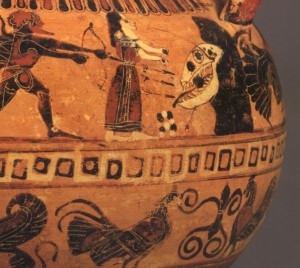
"The art below is from the Mesopotamian cylinder seal of Uruk, an artifact currently housed at the Louvre. The animal on the right is an artist’s conception from a skeleton of an Apatosaurus. 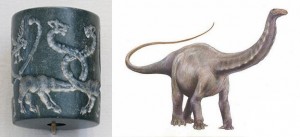 There are many striking similarities between these two depictions. The legs and feet on the artifact clearly fit the sauropods better than any other type of animal. The biggest difference is at the head. Cartilage forming the shape of a frill or ears may be stylized or accurate (since there is no way to know from the skeletons we have today). As for the musculature, the ancient artist draws with stunning realism. One has to ask where the artist got the model to draw so convincingly the trunk of a sauropod."
There are many striking similarities between these two depictions. The legs and feet on the artifact clearly fit the sauropods better than any other type of animal. The biggest difference is at the head. Cartilage forming the shape of a frill or ears may be stylized or accurate (since there is no way to know from the skeletons we have today). As for the musculature, the ancient artist draws with stunning realism. One has to ask where the artist got the model to draw so convincingly the trunk of a sauropod."
To the right are displayed slate palettes from Hierakonpolis showing the triumph of King Nar-mer with long necked dragons and an ancient palette depicting a pair of “dinosaur-like” creatures along with numerous clear representations of living animals (taken from p. 93 of Pritchard’s book The Ancient Near East in Pictures).
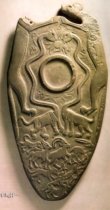
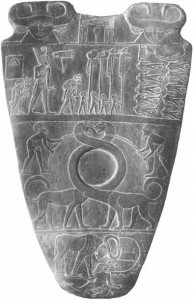
"is pictured an Ica Ceremonial Burial Stone from the Nasca culture (100 BC to 800AD). In 1500s the Spanish Conquistadors brought back stories that there were stones with strange creatures carved on them found in Peru. Some of the stones were even brought back to Spain. The Incan Chronicler Juan de Santa Cruz Pachucuti Lumqui wrote in 1571 about the strange engraved stones in Ica. (See Swift, Dennis, Secrets of the Ica Stones, 2006.)"
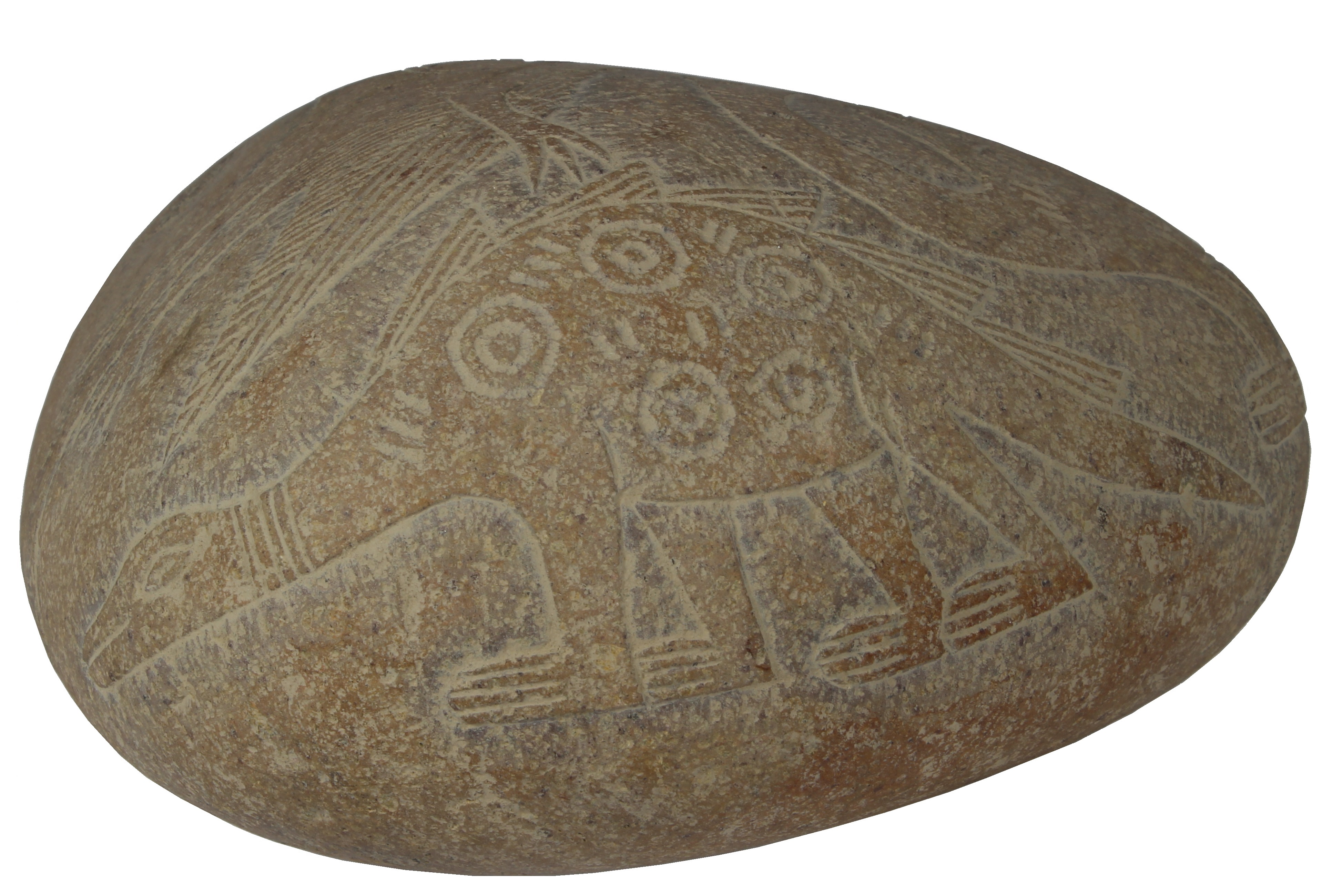
"Not far from the South American Nasca sites are the Moche Indian archaeological locations. These Moche tribes inhabited northern Peru about 100-800 AD. Among the artifacts currently in the Lima museums are the Moche stirrup-spout pots (left). These are their main artistic medium, featuring red & white ceramic pots displaying realistic medical procedures, combative events, musical instruments, plants and animals. Official guides at Peru’s numerous museums and archaeological sites will tell you that the native cultures depicted only things that they saw in nature. So what inspired the dragon-like images like that on the canchero to the right?"
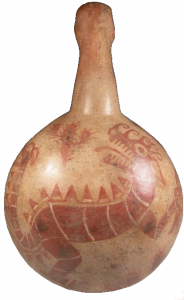
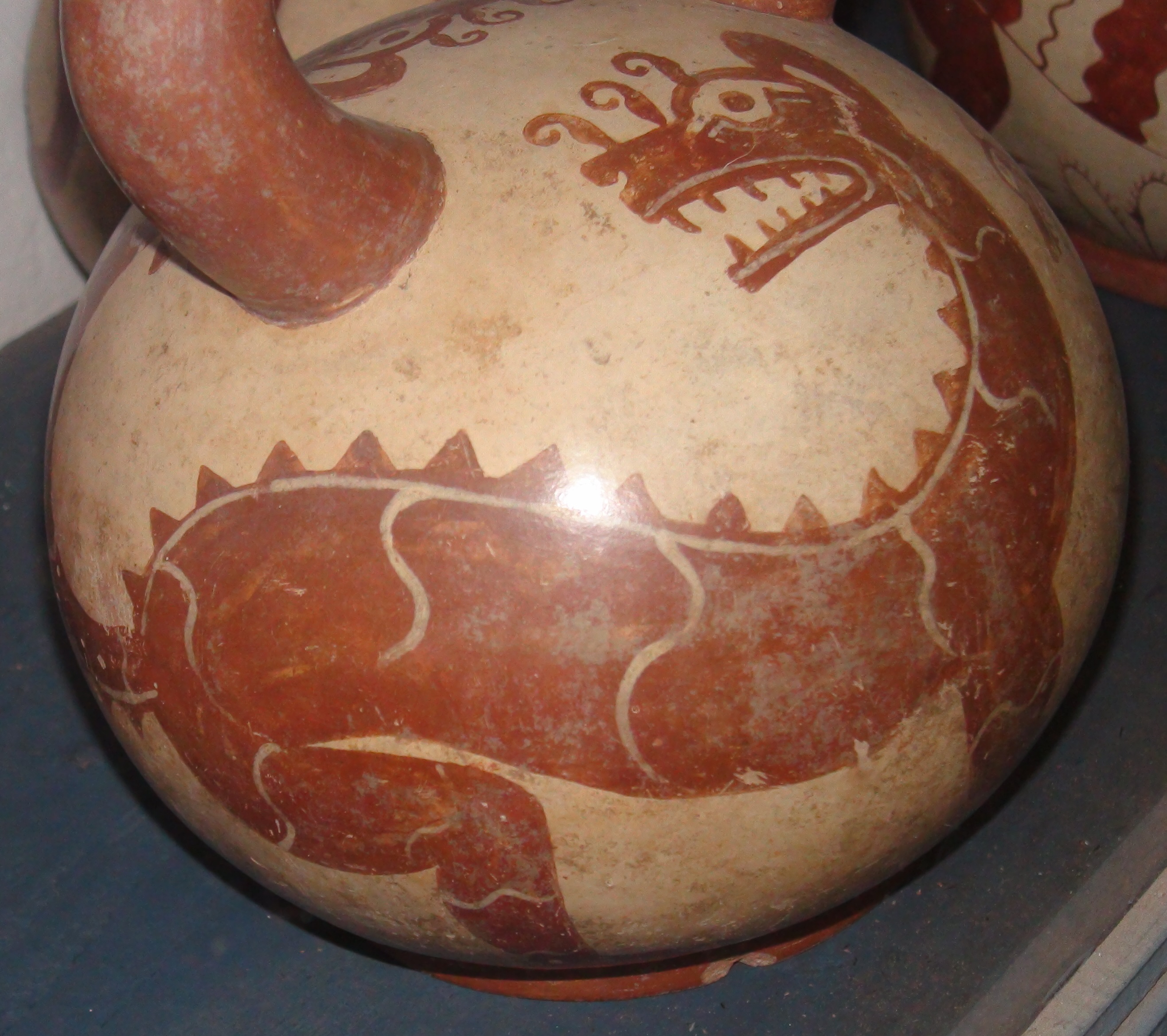
"Deep in the jungles of Cambodia are ornate temples and palaces from the Khmer civilization. One such temple, Ta Prohm, abounds with stone statues and reliefs. Almost every square inch of the gray sandstone is covered with ornate, detailed carvings. These depict familiar animals like monkeys, deer, water buffalo, parrots, and lizards. However, one column contains an intricate carving of a stegosaur-like creature. But how could artisans decorating an 800 year old Buddhist temple know what a dinosaur looked like? Western science only began assembling dinosaurs skeletons in the past two centuries"

"In 1496 the Bishop of Carlisle, Richard Bell, was buried in Carlisle Cathedral in the far northern England, near the Scottish border. The tomb (see right) is inlaid with brass, having various animals engraved upon it. Although worn by the countless feet that walked over it since the Middle Ages, a particular depiction is unmistakable in its similarity to a dinosaur. It appears to be two sauropod dinosaurs with necks entangled."

There are stories of a plesiosaur-like creature seen in Queensland, Australia. Both aboriginal peoples around Lake Galilee and tribes farther up to the north tell of a long-necked animal with a large body and flippers. “Elders of the Kuku Yalanji aboriginal tribe of Far North Queensland, Australia, relate stories of Yarru (or Yarrba), a creature which used to inhabit rain forest water holes. The painting [left] depicts a creature with features remarkably similar to a plesiosaur. It even shows an outline of the gastro-intestinal tract, indicating that these animals had been hunted and butchered.” (CEN Technical Journal, Vol.12, No. 3, 1998, p. 345.)

"In 1945 archaeologist Waldemar Julsrud discovered clay figurines buried at the foot of El Toro Mountain on the outskirts of Acambaro, Mexico. Eventually over 33,000 ceramic figurines were found in the area and identified with the Pre-classical Chupicuaro Culture (800 BC to 200 AD). The authenticity of Julsrud’s find has been challenged because the huge collection included dinosaurs..."
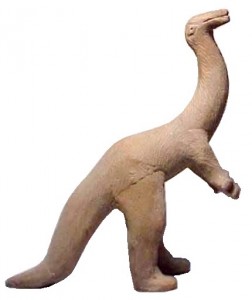
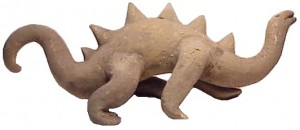
"To the ... is an artifact from Tiwanaku, an important Pre-Columbian archaeological site in Bolivia. Tiwanaku is recognized by Andean scholars as one of the most important precursors to the Inca Empire. The sculptor depicted a dinosaur-like creature at least 800 years before European scientists discovered dinosaurs. A vase depicting dueling dinosaurs ... has also been discovered in the Tiwanaku region. It is believed to date from 500 – 1000 A.D. and closely resembles the Nasca dinosaurian depictions."
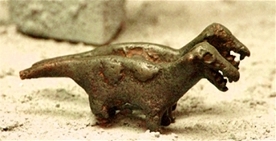
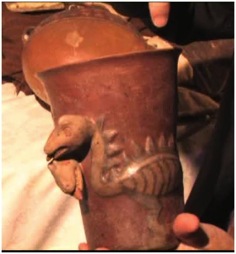
"...Roman mosaic from about 200 AD that depicts two long-necked sea dragons.."
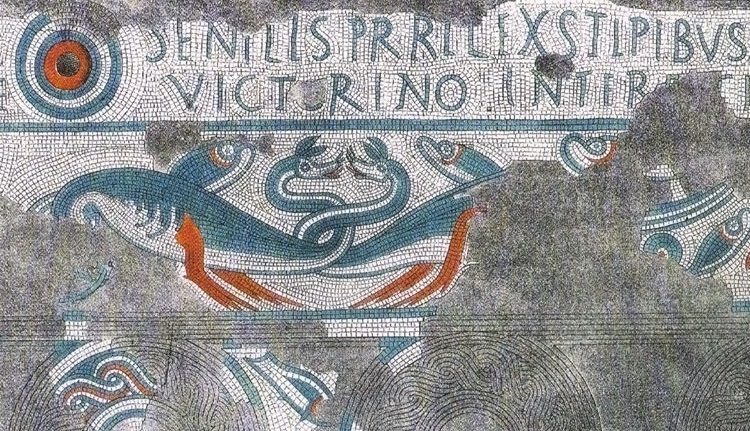
Source:http://www.genesispark.com/exhibits/evidence/historical/ancient/dinosaur/
""Fran Barnes, a recognized authority on rock art of the American South-West, (who "despises" creationists") writes, In the San Rafael Swell, there is a pictograph [picture symbol] that looks very much like a pterosaur a Cretaceous flying reptile..." (Swift, Dennis, "Messages on Stone," Creation Ex Nihilo, vol. 19, p. 20).
This figure, about 7 feet long from wing-tip to wing-tip, is actually painted with a dark-red pigment. Indians of the Fremont culture are thought to have inhabited the "Swell" between 700 and 1250 A.D. Black Dragon Canyon is named for the pictograph which resembles a large winged reptile with a headcrest." http://s8int.com/dinolit3.html
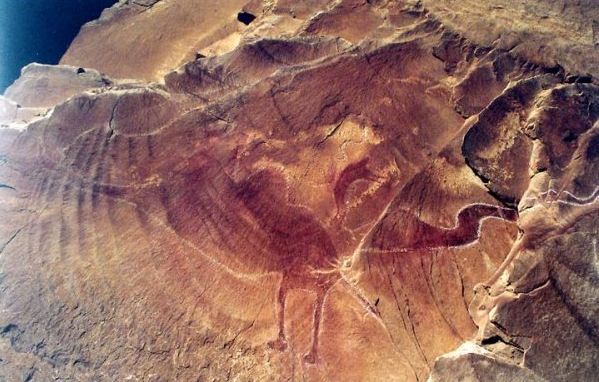
There are many, many more art depictions of dinosaurs/dragons throughout the world. Click here for more http://www.helsinki.fi/~pjojala/dinosaur.htm
You won't learn about this in your science or history classes.
You may inquire "how come there are no historical writtings of dinosaurs?". The answer is there are but you won't find this in your history books.
"“The dragons of legend are strangely like actual creatures that have lived in the past. They are much like the great reptiles which inhabited the earth long before man is supposed to have appeared on earth. Dragons were generally evil and destructive. Every country had them in its mythology.” (Knox, Wilson, “Dragon,” The World Book Encyclopedia, vol. 5, 1973, p. 265.) The article on dragons in the Encyclopaedia Britannica (1949 edition) noted that dinosaurs were “astonishingly dragonlike,” even though its author assumed that those ancients who believed in dragons did so “without the slightest knowledge” of dinosaurs. The truth is that the fathers of modern paleontology used the terms “dinosaur” and “dragon” interchangeably for quite some time."
"After Alexander the Great invaded India he brought back reports of seeing a great hissing dragon living in a cave. Later Greek rulers supposedly brought dragons alive from Ethiopia. (Gould, Charles, Mythical Monsters, W.H. Allen & Co., London, 1886, pp. 382-383.) Microsoft Encarta Encyclopedia (“Dinosaur” entry) explains that the historical references to dinosaur bones may extend as far back as the 5th century BC. In fact, some scholars think that the Greek historian Herodotus was referring to fossilized dinosaur skeletons and eggs when he described griffins guarding nests in central Asia. “Dragon bones” mentioned in a 3rd century AD text from China are thought to refer to bones of dinosaurs.
Ancient explorers and historians, like Josephus, told of small flying reptiles in ancient Egypt and Arabia and described their predators, the ibis, stopping their invasion into Egypt. (Epstei+n, Perle S., Monsters: Their Histories, Homes, and Habits, 1973, p.43.) A third century historian Gaius Solinus, discussed the Arabian flying serpents, and stated that “the poison is so quick that death follows before pain can be felt.” (Cobbin, Ingram, Condensed Commentary and Family Exposition on the Whole Bible, 1837, p. 171.) The well-respected Greek researcher Herodotus wrote: “There is a place in Arabia, situated very near the city of Buto, to which I went, on hearing of some winged serpents; and when I arrived there, I saw bones and spines of serpents, in such quantities as it would be impossible to describe. The form of the serpent is like that of the water-snake; but he has wings without feathers, and as like as possible to the wings of a bat.” (Herodotus, Historiae, tr. Henry Clay, 1850, pp. 75-76.) Herodotus has been called “the Father of History” because he was the first historian we know who collected his materials systematically and then tested them for accuracy. John Goertzen noted the Egyptian representation of tail vanes with flying reptiles and concluded that they must have observed pterosaurs or they would not have known to sketch this leaf-shaped tail. He also matched a flying reptile, observed in Egypt and sketched by the outstanding Renaissance scientist Pierre Belon, with the Dimorphodon genus of pterosaur. (Goertzen, J.C., “Shadows of Rhamphorhynchoid Pterosaurs in Ancient Egypt and Nubia,” Cryptozoology, Vol 13, 1998.)"
"The first century Greek historian Strabo, who traveled and researched extensively throughout the Mediterranean and Near East, wrote a treatise on geography. He explained that in India “there are reptiles two cubits long with membranous wings like bats, and that they too fly by night, discharging drops of urine, or also of sweat, which putrefy the skin of anyone who is not on his guard;” (Strabo, Geography: Book XV: “On India,” Chap. 1, No. 37, AD 17, pp. 97-98.) Strabos account may have been based in part on the earlier work of Megasthenes (ca 350 – 290 BC) who traveled to India and states that there are “snakes (ophies) with wings, and that their visitations occur not during the daytime but by night, and that they emit urine which at once produces a festering wound on any body on which it may happen to drop.” (Aelianus, Greek Natural History:On Animals, 3rd century AD, 16.41.)"
"The Chinese have many stories of dragons. Some ornamental pictures of dragons are shaped remarkably like dinosaurs. Marco Polo wrote of his travels to the province of Karajan and reported on huge serpents, which at the fore part have two short legs, each with three claws. “The jaws are wide enough to swallow a man, the teeth are large and sharp, and their whole appearance is so formidable that neither man, nor any kind of animal can approach them without terror.” (Polo, Marco, The Travels of Marco Polo, 1961, pp. 158-159.) Books even tell of Chinese families raising dragons to use their blood for medicines and highly prizing their eggs. (DeVisser, Marinus Willem, The Dragon in China & Japan, 1969.).."
"“Among Serpents, we find some that are furnished with Wings. Herodotus who saw those Serpents, says they had great Resemblance to those which the Greeks and Latins call’d Hydra; their Wings are not compos’d of Feathers like the Wings of Birds, but rather like to those of Batts; they love sweet smells, and frequent such Trees as bear Spices. These were the fiery Serpents that made so great a Destruction in the Camp of Israel…The brazen Serpent was a Figure of the flying Serpent, Saraph, which Moses fixed upon an erected Pole: That there were such, is most evident. Herodotus who had seen of those Serpents, says they very much resembled those which the Greeks and Latins called Hydra: He went on purpose to the City of Brutus to see those flying Animals, that had been devour’d by the Ibidian Birds.” (Owen, Charles, An Essay Towards a Natural History of Serpents, 1742, pp. 191-193.)"
"The 16th century Italian explorer Pigafetta, in a report of the kingdom of Congo, described the province of Bemba, which he defines as “on the sea coast from the river Ambrize, until the river Coanza towards the south,” and says of serpents, “There are also certain other creatures which, being as big as rams, have wings like dragons, with long tails, and long chaps, and divers rows of teeth, and feed upon raw flesh. Their colour is blue and green, their skin painted like scales, and they have two feet but no more. The Pagan negroes used to worship them as gods, and to this day you may see divers of them that are kept for a marvel. And because they are very rare, the chief lords there curiously preserve them, and suffer the people to worship them, which tendeth greatly to their profits by reason of the gifts and oblations which the people offer unto them.” (Pigafetta, Filippo, The Harleian Collections of Travels, vol. ii, 1745, p. 457.)"
"John Harris was a scientific man that edited the first encyclopedia. He gives a singularly account of the capture of a dragon: “We have, in an ancient author, a very large and circumstantial account of the taking of a dragon on the frontiers of Ethiopia, which was one and twenty feet in length, and was carried to Ptolemy Philadelphus, who every bountifully rewarded such as ran the hazard of procuring him this beast.” (Harris, John, Collection of Voyages, vol. i, London, 1764, p. 474.) But this pales in comparison to the account St. Ambrose gives of dragons “seen in the neighbourhood of the Ganges nearly seventy cubits in length.” (Ambrose, De Moribus Brachmanorum, 1668.) It was one of this size that Alexander and his army saw in a cave. “Its terrible hissing made a strong impression on the Macedonians, who, with all their courage, could not help being frighted at so horrid a spectacle.” (Aelian, De Animal, lib. XV, cap. 21.) "
Source: http://www.genesispark.com/exhibits/evidence/historical/dragons/
More interesting videos for your viewing pleasure
https://www.youtube.com/watch?feature=player_embedded&v=xZaipz_0ovw
https://www.youtube.com/watch?feature=player_embedded&v=zJAii5n0KIo






































.jpg)


















